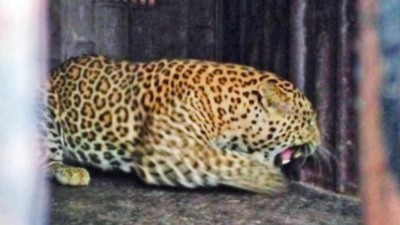Freed in forests, leopards return to sugar cane fields in Junnar

The forest department on Wednesday trapped this nine-year-old female leopard from a farm in Adgaon, on the outskirts of Nashik city. The leopard had attacked a person around a month ago
PUNE: An analysis of leopards captured and released into the wild in the Junnar forest division has revealed that the animals tend to return to sugar cane fields close to human habitations.
The pattern has been observed in at least 10-15 instances of leopards released within the forest division's limits mainly due to the easy availability of prey in the form of stray dogs, cattle and other domestic animals, a senior forest official said.
Amol Satpute, deputy conservator of forest, Junnar division, told TOI, "This is also why sightings of leopards in the forest pockets, such as Bhimashankar sanctuary and other areas in Junnar division, have reduced significantly in the past few years. These animals are now mostly found in sugar cane fields."
He added that forest grasslands have also reduced over the years, due to which herbivores were fewer in number. As a result, carnivores such as leopards have had to migrate to areas where they can get food.
"In Junnar, leopards do not stay in forests anymore, even if you release them into their natural habitat, because they do not easily get food. But near the human habitations, they get easy prey in the form of strays and domestic animals. This is also resulting in human-animal conflict," Satpute said.
To better understand the issue that has spanned the last two decades, the forest division had roped in a team of experts from the Wildlife Institute of India (WII) to carry out a leopard count. The aim is to take scientific measures for mitigating human-animal conflict in the division.
In the past two years, the WII has completed its survey in five blocks. Each block consists of at least five villages, or more, depending upon the size. "As per our observations, one peculiar aspect in the captured leopard cases is that they return to the same village, even if released in the forest pockets as far as 80km away.
It indicates how an animal prefers areas where easy prey and water are available, besides finding safe shelter in sugar cane fields," said an expert from WII, who did not wish to be named.
WII experts install trap cameras within a 2km radius of villages, where sightings of animals are high. "They then study the captured images and analyse animal behaviour in detail," a forest official said.
Jambut, where a 19-year-old girl died in a leopard attack recently, is among the few villages that are leopard-populated in the division. The forest department has paid a compensation of Rs20 lakh to the deceased girl's family. Fear prevailed in Jambut and 10 surrounding villages after the latest leopard attack. At present, the department has placed trap cages to catch the leopard at Jambut village.
The pattern has been observed in at least 10-15 instances of leopards released within the forest division's limits mainly due to the easy availability of prey in the form of stray dogs, cattle and other domestic animals, a senior forest official said.
Amol Satpute, deputy conservator of forest, Junnar division, told TOI, "This is also why sightings of leopards in the forest pockets, such as Bhimashankar sanctuary and other areas in Junnar division, have reduced significantly in the past few years. These animals are now mostly found in sugar cane fields."
He added that forest grasslands have also reduced over the years, due to which herbivores were fewer in number. As a result, carnivores such as leopards have had to migrate to areas where they can get food.
"In Junnar, leopards do not stay in forests anymore, even if you release them into their natural habitat, because they do not easily get food. But near the human habitations, they get easy prey in the form of strays and domestic animals. This is also resulting in human-animal conflict," Satpute said.
To better understand the issue that has spanned the last two decades, the forest division had roped in a team of experts from the Wildlife Institute of India (WII) to carry out a leopard count. The aim is to take scientific measures for mitigating human-animal conflict in the division.
In the past two years, the WII has completed its survey in five blocks. Each block consists of at least five villages, or more, depending upon the size. "As per our observations, one peculiar aspect in the captured leopard cases is that they return to the same village, even if released in the forest pockets as far as 80km away.
It indicates how an animal prefers areas where easy prey and water are available, besides finding safe shelter in sugar cane fields," said an expert from WII, who did not wish to be named.
WII experts install trap cameras within a 2km radius of villages, where sightings of animals are high. "They then study the captured images and analyse animal behaviour in detail," a forest official said.
Jambut, where a 19-year-old girl died in a leopard attack recently, is among the few villages that are leopard-populated in the division. The forest department has paid a compensation of Rs20 lakh to the deceased girl's family. Fear prevailed in Jambut and 10 surrounding villages after the latest leopard attack. At present, the department has placed trap cages to catch the leopard at Jambut village.
FOLLOW US ON SOCIAL MEDIA
FacebookTwitterInstagramKOO APPYOUTUBE
Start a Conversation
end of article









